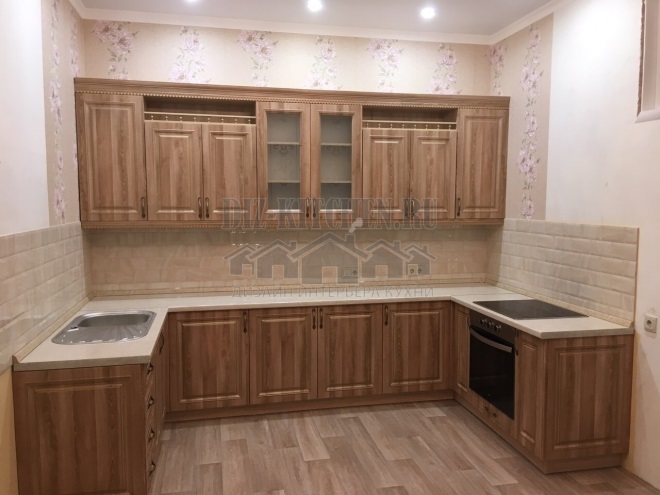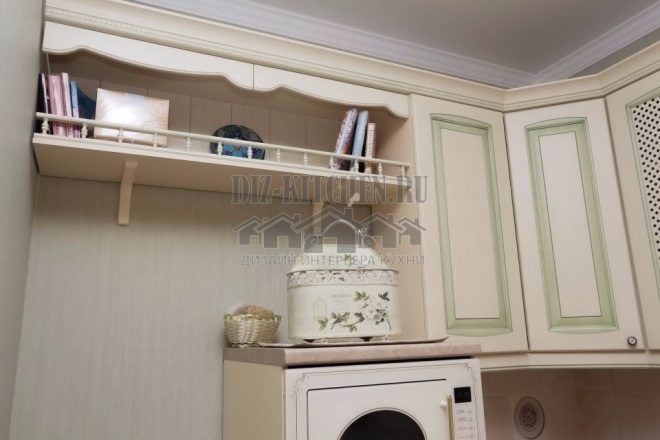At the stage of planning a kitchen renovation, a number of questions arise before the owner, one of which is the need to install a kitchen hood. It is no longer possible to imagine modern housing without this technology, because thanks to the ventilation system, the process of daily cooking has become more comfortable. The interior hood is not only a fashionable element. It eliminates the problem of burning odors throughout the home, providing clean and fresh air in the room. If the kitchen is combined with a dining area or living room, and with a small living space and with other rooms, then you cannot do without a hood.

Image taken from https://www.youtube.com/watch? v = 9A7p9rJxoec
Advantages and disadvantages of kitchen hoods
The kitchen is the place where food is prepared, which means that steam, fat and smoke appear during the heat treatment of food. From these "side" phenomena, not only the hostess becomes uncomfortable with household chores, but the condition of the furniture deteriorates, the air becomes polluted. Thus, the hood performs a very important task - it cleans the air.
There is an opinion that the need to install a hood arises only for those who use a gas stove. This is only partly true. Cooking food on modern induction and electric cookers creates less soot and smoke, but does not eliminate the problem of strong odors spreading throughout the room.
Attention! Earned on our website kitchen designer. You can familiarize yourself with it and design your dream kitchen for free! May also come in handy wardrobes designer.
Additional advantages of this technique
- Cooking in the kitchen becomes much more enjoyable. The hood 100% copes with strong smells of food, steam, smoke, does not allow them to spread throughout the house.
- Another source of lighting.
- Strengthens the air flow into the apartment and maintains a healthy microclimate.
- Absorption of excess moisture.
- Work surface cleanliness. During the cooking process, the fat spreads throughout the entire perimeter, reaching the ceiling, leaving plaque everywhere. It will be easier to keep the kitchen, where the hood is installed, clean. Therefore, every time you turn on the stove, you need to turn on this device.
- The whole kitchen will be much cleaner.

Image taken from https://www.youtube.com/watch? v = 9A7p9rJxoec
But there are people who do not consider it necessary to install a hood in their home and consider it absolutely useless. Let's analyze the disadvantages:
- During the operation of any ventilation device, noise occurs, which annoys many. You can avoid this by choosing silent or low-noise models.
- Kitchen smells do not bother some people. Therefore, the declared functions of this technique will be useless for them.
- Some housewives cope with cooking without additional devices, but simply open the windows wide open and ventilate the room.
- It is not always possible to install a hood in small kitchens due to its size. In this case, you can search for a portable or portable model for sale (it is also called a construction model).
- The hood is a device that must be directly connected to the ventilation, which can provoke draft problems in the ventilation shafts of neighboring apartments.
- The hood filter quickly becomes dirty and accumulates dirt and grease, making it an ideal breeding ground for pathogenic bacteria.
- The high cost of technology.
To decide on the need to install a hood in the house, you need to consider all the options and make an informed decision.
Types of hoods and their photos in the interior
A properly selected kitchen hood in the interior will cope with many tasks: it will be a stylish accessory and will protect against fumes, grease, excessive humidity and overheating. To make the right choice, it should be borne in mind that all devices are distinguished according to the following criteria:
- design features;
- performance;
- work algorithm;
- power;
- the amount of power consumption;
- additional options;
- price.
Let's consider the main types and their differences from each other.
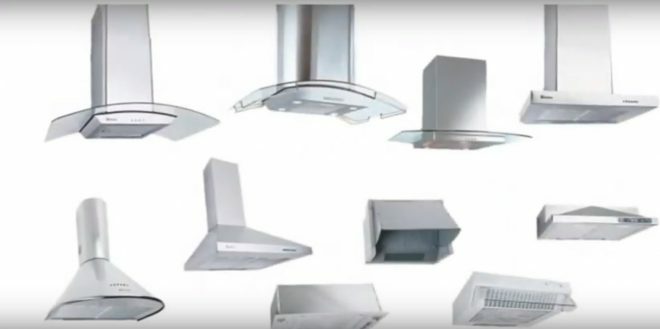
Classic cooker hood
The unit is small in size, mounted above the stove, often the duct is decorated or hidden behind a kitchen cabinet. This is a suspended type of construction, the installation of which is simple, and the operation does not require special maintenance. This technique is always in sight, so it is important that it blends harmoniously into the interior.

Image taken from https://www.youtube.com/watch? v = 9A7p9rJxoec
Built-in cooker hood
This option is convenient when it is undesirable to display the device (for example, it does not fit the interior). Small kitchens are often equipped with this ergonomic model. The hood is mounted in a cabinet above the stove, which saves space. Work efficiency is enhanced by a pull-out panel.

Image taken from https://www.youtube.com/watch? v = 9A7p9rJxoec
Retractable cooker hood
A type of built-in appliances is a retractable hood. Due to the retractable work surface, it is often installed in kitchens with a small square. It is presented in different types of structures: folding, slider, telescopic. Most often this is a flat design, without additional branches and pipes.

Image taken from https://www.youtube.com/watch? v = 9A7p9rJxoec
Dome hood
A popular model that looks like a dome or fireplace. The pipes are hidden behind the box, and the other mechanisms with gratings and filters are located in the dome. Dome devices, due to their design features and large dimensions, are considered one of the most powerful of all.
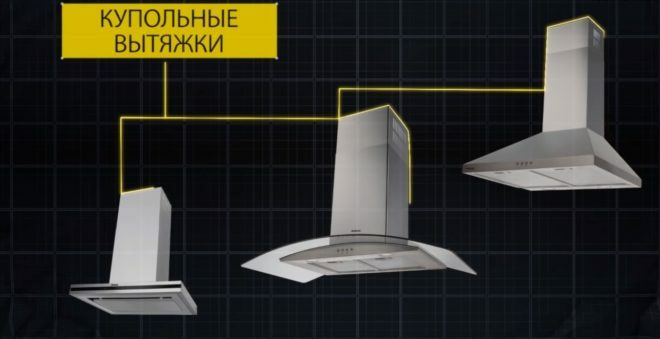
Image taken from https://www.youtube.com/watch? v = mgSbYJG4FvA
Island hood
They are much less common in apartments than in country houses, since installation is quite laborious. Based on the name, the features of this technique are clear: all communications are brought from the ceiling, there are no restrictions in form. In the interior, a round kitchen hood is one of the most stylish and effective options, suitable for modern styles (loft, minimalism).

Image taken from https://www.youtube.com/watch? v = mgSbYJG4FvA
Criteria for choosing a hood for the kitchen
In order for the hood in the interior of the kitchen to perform all tasks, the main factors must be taken into account:
Performance
This parameter means the amount of air that the hood can clean in 1 hour of operation. This parameter is influenced by the footage of the room, the design and the type of the built-in motor. You can calculate the performance using special formulas, and this data is also in the instructions for a particular model.

Image taken from https://www.youtube.com/watch? v = mgSbYJG4FvA
The size
The width of the hood must be at least equal to the width of the hob. If it is less, then most likely it will not cope with its tasks and will purify the air more slowly. So, for example, if the width of the slab is 60 cm, then it is better to buy a hood 20 cm wider. If, due to the design of the kitchen unit or the lack of space above the stove, this rule cannot be observed, you can choose another model of a small size, but with a higher power.
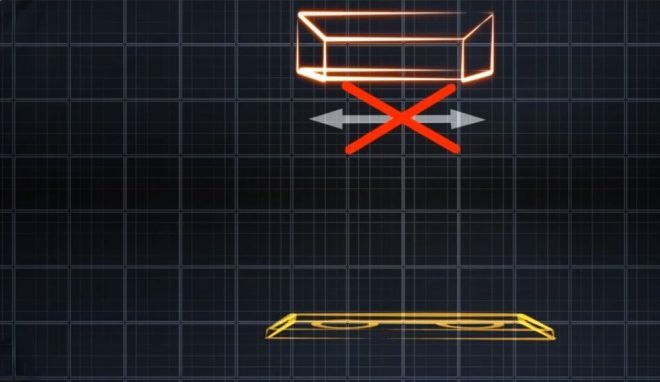
Image taken from https://www.youtube.com/watch? v = mgSbYJG4FvA
Modes of operation
Kitchen appliances work according to 2 principles:
- venting air into the ventilation duct,
- its forced ventilation (circulation).
The exhaust mode model is considered to be the most efficient. When installing a hood that works on the principle of ventilation, you need to constantly purchase replaceable filters and replace them as they become dirty.

Filter models
The complete set of any hood in the interior of the kitchen has filter elements, which are of several types:
- Fine cleaning - disposable carbon elements. The need to replace them must be monitored independently, it depends on the intensity of operation.
- Coarse cleaning - fine mesh made of stainless steel or aluminum, which retain particles of soot and grease on their surface. These are reusable filters that do not require any special care and are easy to clean.
- Intermediate filter elements - a mesh made of synthetic material, is a disposable element that needs to be replaced as it gets dirty. Their condition must be monitored especially carefully, because a mesh that has exhausted its resource can disrupt the operation of the entire device.
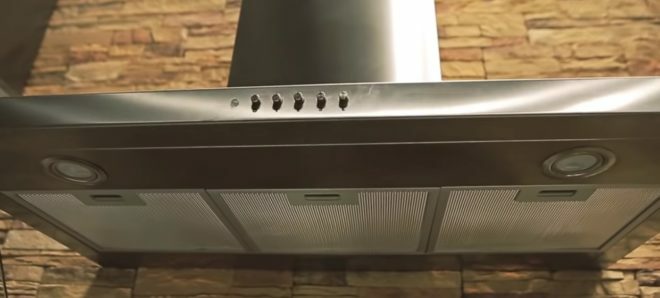
Image taken from https://www.youtube.com/watch? v = mgSbYJG4FvA
Ways of work
Modern hoods work depending on the type of air extraction. And he, in turn, depends on the possibility of connecting to the ventilation shaft. Main modes:
- Flowing. Standard type, with the existing air outlet mechanism to the street or to the ventilation duct. Not suitable for old buildings (where ventilation is clogged or not designed for heavy loads), as well as for housing with no ventilation in the project (outbuildings, temporary huts, summer cottages).
- Recirculating. The basic principle is air purification through a filter system in the hood itself.
- Combined, with the ability to switch modes from flow to recirculation.

Image taken from https://www.youtube.com/watch? v = mgSbYJG4FvA
Additional options
It is worth paying special attention to the optional, but also necessary functions:
- Residual ventilation stroke - after switching off, the device continues to work and cleans the air for another 5-15 minutes.
- Interval inclusion. For example, the cooker hood switches on automatically several times an hour or a day to freshen the air. Airing is very important, even if food is not being prepared during this time.
- An electronic timer allows the device to turn off automatically after a specified time.
- Illuminated as an additional source of lighting in the kitchen.
On sale you can find equipment with several types of control:
- traditional, with a push-button system;
- slider type;
- touch control;
- remote, on the control panel.
Touch and remote control are the most convenient to use and easier to clean from dirt.

Body material
The hood body can be presented in several variations:
- Tempered glass is the most expensive option; it looks very prestigious and aesthetically pleasing. The only negative is that there are no narrow models (starting from 60 cm).
- Aluminum - the cooker hood is very durable, but quite expensive. Does not require special care, can be washed with any detergent. There are no fingerprints on the surface, the case is not subject to corrosion.
- Stainless steel - such models serve for a long time, have a democratic price. In a modern kitchen, they look stylish, they are also unpretentious in care, the only thing is that they cannot be washed with metal sponges and using cleaning agents with abrasive particles.
- Enamelled metal is reliable and strong, and the cost of such equipment is low.
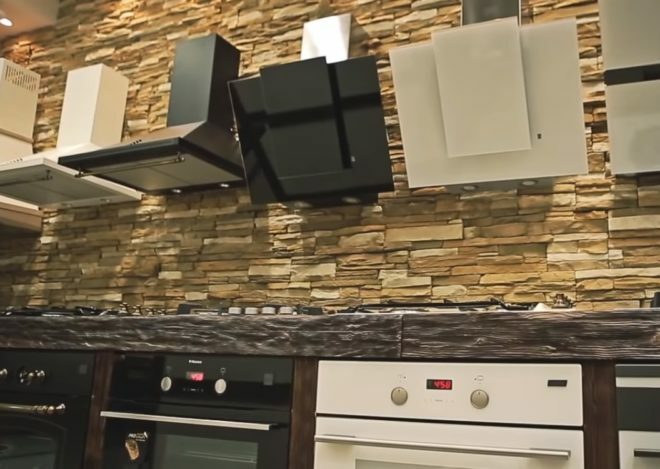
Image taken from https://www.youtube.com/watch? v = mgSbYJG4FvA
How to choose a good range hood
The cooker hood is responsible for the fresh air in the kitchen, as well as for the absence of dirt on furniture, walls and even the ceiling. When choosing this technique, experts recommend paying attention to:
- The air pressure generated by the motor. A high indicator indicates good performance of the unit.
- Mode of operation. Devices connected to ventilation shafts work better than in recirculation mode.
- Density of filters - the denser they are, the faster and better the air is cleaned. There are fatty (coarse cleaning from the most weighty air inclusions) and thinner coal, eliminating odors and harmful impurities.
- The presence of a mode that allows you to quickly clean the air in extreme conditions.
- The size. The coverage area depends on the dimensions of the hood.
- The installation method affects the appearance and relevance for a particular kitchen space.
The hood is a real orderly in the kitchen, which absorbs all foreign odors, grease and smoke, providing fresh air. Therefore, you should not save on it. Taking into account all the recommendations, you can choose the right model, which will be an original accessory that works effectively and brings great benefits.
